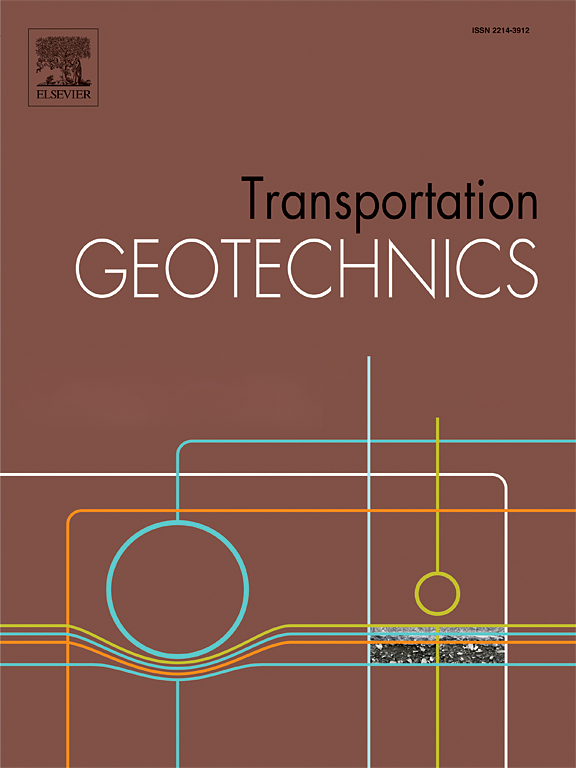Seismic resilience assessment of highway embankments: considering damage measure of hysteretic energy dissipation
IF 4.9
2区 工程技术
Q1 ENGINEERING, CIVIL
引用次数: 0
Abstract
The wide spatial distribution of highway transportation infrastructure increases its exposure to earthquakes during its service life, thereby raising the risk of damage, particularly for structures with high vulnerability. Therefore, the concept of seismic resilience has attracted extensive attention from academia and the engineering community in recent years. Previous researches on the seismic performance of embankments focused on fragility analysis, and permanent ground displacement (PGD) from field investigations was adopted as a damage measure (DM). However, it cannot explicitly reflect the dynamic response and damage mechanism during earthquakes, and whether it can precisely reflect the damage state (DS) also requires further research. In addition, some preliminary frameworks have been established for the seismic resilience of embankments, but there are no quantitative assessment methods and results. In view of this, a complete framework including hazard analysis, fragility analysis and resilience assessment is proposed to evaluate the seismic resilience of a high-filled embankment. To effectively reflect the damage mechanism of the structure, the DM of hysteretic energy dissipation and corresponding classification criteria of different DSs are established. The dynamic response and damage mechanism of embankments are analyzed through finite element nonlinear dynamic analysis, and the fragility analysis is carried out based on the DM of hysteretic energy dissipation. Ultimately, the resilience of embankments at different seismic scenarios is evaluated by combining the restoration functions under different DSs, and the effects of embankment height and embankment slope gradient are analyzed to effectively guide the seismic design. The results show that at the peak ground acceleration (PGA) of 0.4 g, the resilience of the embankment shows a significant decrease due to the lower robustness and rapidity, and the resilience index decreases to 0.79. The resilience index shows a nonlinear decreasing trend with the increase of embankment height, and the corresponding resilience indexes of the embankments with the heights of 10 m, 15 m, and 20 m are 0.85, 0.83, 0.79 at the PGA of 0.4 g. As the slope gradient is reduced, the resilience of the embankment has a significant enhancement only when the PGA is greater than 0.2 g, and the resilience indexes under the slope gradients of 1:1.75, 1:2, and 1:2.25 are 0.79, 0.82, and 0.83 at the PGA of 0.4 g. The resilience enhancement realized by the slope grading has a significant marginal effect. The framework is an extension of the traditional seismic performance analysis to optimize the pre-disaster seismic design and post-disaster restoration process, which is important to ensure the normal operation of the highway system and reduce the socio-economic costs.
考虑滞回耗能损伤措施的公路路堤抗震回弹评价
公路交通基础设施的广泛空间分布增加了其在使用寿命期间遭受地震的风险,从而增加了损坏的风险,特别是对高易损性结构。因此,近年来,地震回弹的概念受到了学术界和工程界的广泛关注。以往对路堤抗震性能的研究主要集中在易损性分析上,并采用现场调查所得的永久地面位移(PGD)作为损伤测度。但它不能明确反映地震时的动力响应和损伤机制,能否准确反映损伤状态(DS)还有待进一步研究。此外,对堤防的抗震性能也建立了一些初步的框架,但还没有定量的评价方法和结果。基于此,提出了一个包括危害分析、易损性分析和恢复力评价的完整框架来评价高填方路堤的地震恢复力。为了有效地反映结构的损伤机理,建立了滞回能量耗散分值及不同分值的分类标准。通过有限元非线性动力分析分析了路堤的动力响应和损伤机理,并基于滞回耗能模型进行了易损性分析。最后,结合不同dp下的恢复功能,评价不同地震情景下路堤的恢复能力,并分析路堤高度和路堤坡度的影响,有效指导抗震设计。结果表明:在峰值地面加速度(PGA)为0.4 g时,由于鲁棒性和快速性较低,路堤的回弹性明显下降,回弹性指数降至0.79;恢复指数随路堤高度的增加呈非线性下降趋势,在PGA为0.4 g时,路堤高度为10 m、15 m和20 m的恢复指数分别为0.85、0.83和0.79。随着坡面坡度的减小,只有PGA大于0.2 g时路堤的回弹性才有明显增强,在坡面坡度为1:1.75、1:2和1:2.25时,PGA为0.4 g时,路堤的回弹性指数分别为0.79、0.82和0.83。边坡级配所实现的恢复力增强具有显著的边际效应。该框架是对传统抗震性能分析的延伸,用于优化灾前抗震设计和灾后恢复过程,对保证公路系统的正常运行和降低社会经济成本具有重要意义。
本文章由计算机程序翻译,如有差异,请以英文原文为准。
求助全文
约1分钟内获得全文
求助全文
来源期刊

Transportation Geotechnics
Social Sciences-Transportation
CiteScore
8.10
自引率
11.30%
发文量
194
审稿时长
51 days
期刊介绍:
Transportation Geotechnics is a journal dedicated to publishing high-quality, theoretical, and applied papers that cover all facets of geotechnics for transportation infrastructure such as roads, highways, railways, underground railways, airfields, and waterways. The journal places a special emphasis on case studies that present original work relevant to the sustainable construction of transportation infrastructure. The scope of topics it addresses includes the geotechnical properties of geomaterials for sustainable and rational design and construction, the behavior of compacted and stabilized geomaterials, the use of geosynthetics and reinforcement in constructed layers and interlayers, ground improvement and slope stability for transportation infrastructures, compaction technology and management, maintenance technology, the impact of climate, embankments for highways and high-speed trains, transition zones, dredging, underwater geotechnics for infrastructure purposes, and the modeling of multi-layered structures and supporting ground under dynamic and repeated loads.
 求助内容:
求助内容: 应助结果提醒方式:
应助结果提醒方式:


